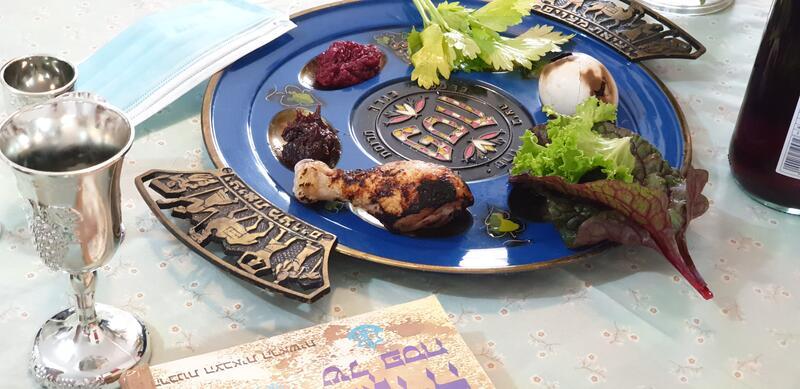Preserving and Refurbishing Passover Traditions
I see my grandmother place the pillows on the plastic-covered couch at the back end of the apartment. In front of it is the dining room table draped in a cut-lace tablecloth, stained with the wine of Passovers past. An aluminum folding table has been placed at the other end, with a similar tablecloth covering its flimsy construction. Together, the tables stretch into the foyer of my grandparents’ cramped Brooklyn apartment, the door open for Elijah.
My grandfather comes in, painfully pinches the cheeks of one or two of his eight grandchildren, and reclines on the pillows, ready to start the seder. A Maxwell House Haggadah is placed at every other table setting—there are never enough for everyone, and we will have to share with someone sitting to our left or right. It won’t matter much to my siblings, my cousins, and me since we are likely scrambling in and out of our seats, only coming to attention when my grandfather calls on one of us to read the Four Questions and again when we are summoned to search for the afikomen. Regardless of who finds it, we are all winners, each of us receiving a dollar and another pinch on the cheek. We end the seder with a rendition of "Dayenu," singing joyfully even though we know it is likely painful for anyone outside the apartment to hear—none of us can carry a tune. My grandmother comes out with the first course, her homemade gefilte fish, and the meal begins.
This was the scene set by my family Passover year after year. The same food. The same Haggadah. The same traditions. The same complaints about my grandfather’s pinching. And I loved every minute of it. Even as a child, I knew that I wanted to keep the tradition going, at the same time that I made Passover my own.
I got the chance to do just that when my parents could no longer do the hosting. It was now up to my sister and me. Like generations of Jewish women before us, we started in the kitchen. We brought some modern twists to the meal, forgoing the homemade gefilte fish in favor of the sweeter, sliceable—and, to me, more palatable—loaf that my sister purchased at Nanna’s, a local Jewish caterer. I added Sephardic-style charoses, with dates instead of apples; made my grandmother’s tzimmes but left out the meat; and baked an Iraqi pistachio cake inspired by one I saw at Zabar’s.
At the same time, we leaned into the traditions of my mother’s and grandmother’s kitchens: matzoh farfel kugel, baseball-sized matzoh balls, and especially Imberlach, a candy/cookie confection. I didn’t know any other family that ate Imberlach, but, for the Frisman family, when it showed up in the kitchen, it was a welcome sign that Passover was here.
When it came time to host my first seder, I approached it just like I did with the new charoses: traditional, but with some modern twists. In the days before make-your-own Haggadahs proliferated the internet, I cut and pasted passages from different books, selecting updated versions of favorite sections. I added some songs set to Broadway showtunes and pop songs, but made sure to leave time for the traditional if tuneless rendition of Dayenu. I threw in a few interactive activities that kept the kids from climbing under the folding table and gave them holiday-themed pages to color. I illustrated the Haggadah with family photos, being sure to include those long gone.
Carrying the torch for family tradition often leads you down paths you never expected. My first challenge came fifteen years ago, when one of my chemotherapy treatments for breast cancer was scheduled for the day of the first seder. Although I was exhausted, it proved to be a minor hiccup: I went to the hospital with my mother and sister in tow, had my treatment, and, after a long nap, directed my sister while she made the tzimmes recipe I’d perfected. I primed the apples and nuts for a simpler take on charoses, and kept quiet about the odd mix of dishes my sister’s mother-in-law brought over.
Since then, I’ve had to adapt the seder in a variety of ways. I’ve made mini-seders in hospital rooms, gotten last minute take-out from a Jewish deli, cooked a meal for fourteen people while trying to get my mother admitted to the hospital, and, like so many of us, led a seder via Zoom in 2020. I’ve turned a rolling hospital tray into a seder plate and my iPad into a Haggadah. When the items for the seder plate proved too difficult to find during those first months of COVID, we turned the search for each item into a family scavenger hunt. Together, we created a virtual seder plate, each family holding up the items they’d found when we got to that part of the seder. “I have an egg,” my aunt repeated several times, trying to be heard over the background noise, since many in the family still didn’t know how to mute themselves.
This year, I’ve had to adapt yet again.
“I don’t think we’re going to do Passover this year,” my aunt told me the other day, explaining that not only won’t my sister and brother-in-law be back in time after a three-month cross-country trip, but my cousin has decided to take his family away on vacation. The rest of the family is spread out across the country. “You should do something with your friends.”
I was disappointed that I wouldn’t be spending the holiday with family. I was also a little worried that this would signal the beginning of the end of our traditions. Would everyone start moving in different directions, leaving memories in their trail?
Still, part of me was relieved. I enjoyed my friends’ longer, more traditional seders, where I was often a “second night” guest. Moving up to “first night” status would be a nice change.
So, I made a new plan.
I called one of my oldest dearest friends, who is essentially family but without the shared DNA. “It looks like I’ll be your guest at Passover,” I told her.
“There’s always a seat at my table for you,” she said.
I knew my offer to cook something would be rebuffed, since she keeps a strictly kosher home. “What can I do to help you?” I asked.
“You know, I was thinking of doing our own Haggadah this year,” she said.
“That I can do,” I assured her.
So, this year, I’ll bring some of my family traditions to Judy’s family. It won’t be my grandfather’s seder and it won’t be the one I’d imagined. But I’ll still love every minute of it. Next year in Jerusalem, we like to say. But really, next year, who knows?








Beautiful, Ilene. And, I look forward to sharing family traditions with you tonight! Happy Passover, Cindy